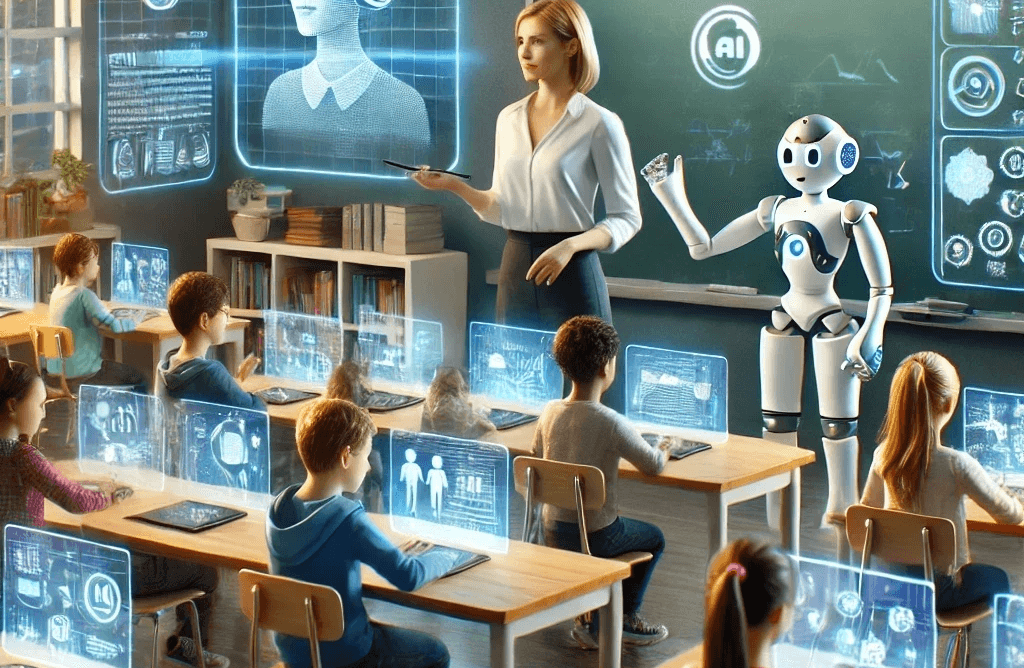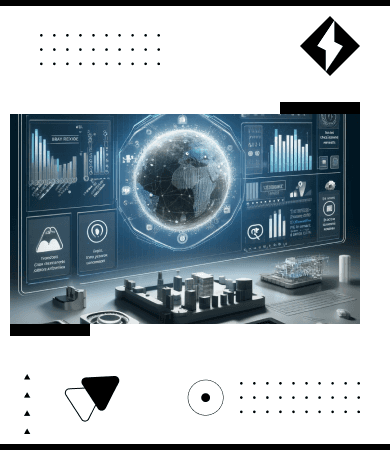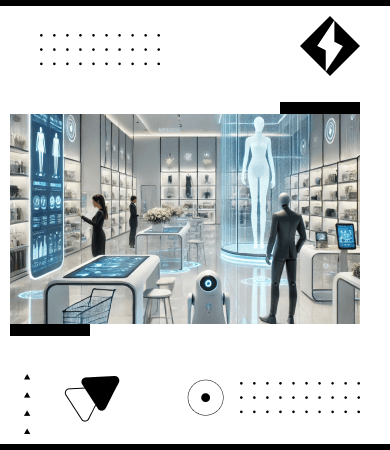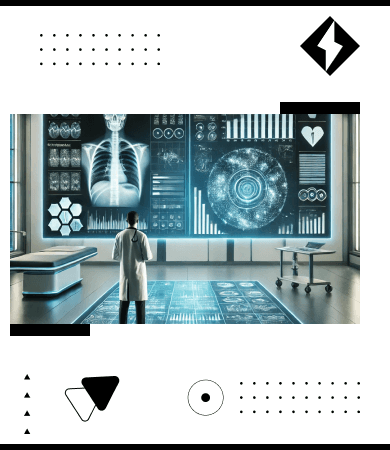Support center +91 97257 89197
Generative AI developmentAugust 20, 2024
How AI is Transforming the Classroom Experience for Students and Educators

Introduction
The landscape of education has seen dramatic shifts over the past decade, with technology driving many of these changes. From the introduction of interactive whiteboards to the adoption of online learning platforms, education has evolved beyond the traditional classroom. However, one of the most transformative forces now shaping this space is artificial intelligence (AI). What once seemed like science fiction—a world where machines learn and teach—is rapidly becoming a reality in modern classrooms.
Artificial intelligence offers an array of possibilities, from personalized learning paths for students to virtual teaching assistants that help educators manage their workload. AI is not just a tool for automating repetitive tasks but a powerful resource that enhances teaching and learning. In this blog, we explore how AI is reshaping the classroom experience for students and educators, transforming everything from lesson planning to student engagement.
The Role of AI in Personalizing Education
One of the most significant impacts of AI in education is its ability to personalize learning. In traditional classrooms, educators often struggle to cater to the individual needs of each student. Differences in learning pace, comprehension, and engagement levels can make it difficult for teachers to provide the personalized attention that students need. This is where AI steps in.
AI-Powered Learning Systems
Adaptive learning platforms such as Knewton and DreamBox are leading examples of how AI can revolutionize education. These platforms utilize machine learning algorithms to analyze student performance in real time. Based on this data, they adjust the difficulty level of lessons, assignments, and even quizzes to match the student’s unique learning style and pace. This creates a personalized educational experience that adapts dynamically as students progress.
For example, if a student struggles with a particular math concept, the system will automatically provide additional resources and exercises to help them master it. On the other hand, if a student excels in a topic, the AI might introduce more challenging problems to ensure continued intellectual growth.
Personalized Feedback
In addition to adaptive learning paths, AI-powered tools offer personalized feedback that is immediate and actionable. Instead of waiting for teachers to grade assignments, students can receive instant insights into their performance. These systems are not limited to simple right or wrong answers; they can analyze student responses to identify patterns and common errors. Based on this analysis, the system provides tailored feedback to help students understand where they went wrong and how to improve.
Benefits for Students
The benefits of personalized AI tools for students are profound. Firstly, they foster a deeper engagement with learning, as students are not bound to a one-size-fits-all curriculum. Secondly, personalized AI tools offer students the chance to learn at their own pace, which helps reduce anxiety and frustration, especially for those who struggle with specific subjects. Research has shown that personalized learning systems can improve student outcomes, with higher retention rates and better performance on assessments.
Case Study: AI in Mathematics Education
A practical example of AI personalization can be seen in mathematics education, where platforms like DreamBox have shown measurable success. In a case study involving elementary students, those who used DreamBox regularly saw a significant improvement in their math scores. The platform’s AI analyzed each student’s problem-solving methods, providing hints and suggestions tailored to their approach. This resulted in not only better performance but also increased confidence in tackling complex problems.
AI as a Teaching Assistant: Helping Educators
While AI’s impact on students is significant, its role in aiding educators is equally transformative. AI functions as a virtual teaching assistant, helping educators streamline their workload, manage classrooms more effectively, and spend more time on teaching rather than administrative tasks.
Automating Grading
Grading assignments, quizzes, and tests is one of the most time-consuming tasks for teachers. AI can automate much of this work, especially for objective questions like multiple-choice or short-answer formats. Tools like Gradescope and Quizlet use AI to scan and assess student submissions, providing instant grades. This allows teachers to focus on more subjective assignments, such as essays or projects, where human insight is critical.
Automating grading also offers consistency. AI systems apply the same criteria to all students, reducing the risk of bias or human error. By handling these tasks, AI frees up valuable time for educators to spend on personalized student interactions and curriculum development.
Classroom Management
Classroom management is another area where AI can assist teachers. Platforms like Classcraft and GoGuardian use AI to monitor classroom activities, ensuring students stay focused and engaged. These tools can track behavior, analyze participation, and even alert teachers if students are distracted or off-task during lessons.
Additionally, these systems can generate reports on student behavior and performance, helping educators identify trends or issues that need addressing. For instance, if a student consistently struggles with a particular subject or disengages during specific activities, AI tools can flag this for the teacher to intervene before it becomes a more significant problem.
Lesson Planning Assistance
AI doesn’t just help manage the day-to-day aspects of classroom life; it can also assist with one of the most fundamental tasks of teaching—lesson planning. Tools like Squirrel AI analyze student data to provide insights into which areas need more focus and which topics students have already mastered. Educators can use this data to create lesson plans that cater to the specific needs of their students, ensuring that each lesson is as effective as possible.
Reducing Administrative Work
Beyond grading and classroom management, AI simplifies administrative tasks such as attendance tracking, scheduling, and communication with parents. AI-powered systems can automatically take attendance, send reminders for upcoming assignments, and even generate personalized progress reports for each student. This reduces the administrative burden on teachers, giving them more time to focus on teaching and student engagement.
Enhancing Student Engagement with AI
AI is not only making classrooms more efficient but also more engaging. By integrating AI into learning experiences, educators can captivate students in new ways.
AI in Gamified Learning
Gamification, the practice of incorporating game-like elements into non-game settings, has proven effective in boosting student engagement. AI takes this a step further by adapting game challenges to the individual learning levels of students. Platforms like Prodigy Math Game use AI to create personalized game experiences, where each student’s progress dictates the next challenge they face. This ensures that students remain engaged while still being challenged at an appropriate level.
Gamified learning with AI also fosters a sense of accomplishment. Students receive rewards, such as badges or points, for completing tasks and mastering skills. This not only motivates them to continue learning but also reinforces positive behaviors, such as persistence and problem-solving.
Virtual Tutors and Chatbots
AI-powered chatbots and virtual tutors provide students with instant help, even outside classroom hours. Tools like Duolingo’s AI-driven chatbots or IBM’s Watson Tutor allow students to ask questions and receive detailed answers anytime, anywhere. These virtual tutors can explain complex concepts, provide additional resources, and even guide students through practice problems.
AI for Students with Special Needs
AI is proving to be a game-changer for students with special needs. By offering tools that assist with communication, learning, and accessibility, AI is making education more inclusive.
Assistive Technologies
AI-driven assistive technologies, such as speech-to-text and text-to-speech tools, have significantly improved learning experiences for students with disabilities. For instance, students with dyslexia can use AI tools that convert written text into spoken words, helping them comprehend reading material more effectively. Similarly, students with visual impairments can use AI to translate written text into audio, ensuring they don’t miss out on key information in lessons.
AI-powered devices can also help students with mobility challenges. Predictive text technologies allow students who struggle with manual dexterity to type more quickly and accurately by predicting what they intend to write. This reduces the physical strain and helps them participate more fully in classroom activities.
Customized Learning Paths
AI can also create customized learning paths for students with conditions such as autism, ADHD, or other cognitive challenges. By analyzing how these students respond to different types of content, AI systems can tailor lessons to meet their specific needs. This level of personalization ensures that students with special needs can learn at their own pace and in ways that best suit their abilities.
For example, AI can identify patterns in a student’s behavior, suggesting strategies to help them focus better or engage more deeply with the material. This kind of targeted support can make a huge difference in helping these students succeed academically.
Supporting Communication
For students who are non-verbal or have limited verbal communication skills, AI-powered Augmentative and Alternative Communication (AAC) tools are making a significant impact. These tools allow students to express themselves using AI-enhanced speech devices, giving them a voice in the classroom. AI's ability to predict and suggest words or phrases based on context also speeds up communication, making interactions smoother and more efficient.
Challenges and Ethical Considerations of AI in Education
While AI offers immense potential in education, it also raises important ethical concerns. Understanding these challenges is critical to ensuring that AI is used responsibly.
Data Privacy Concerns
One of the main concerns around AI in education is the handling of student data. AI systems require large amounts of data to function effectively, including personal information, academic performance, and behavioral patterns. If this data is not properly secured, it can be vulnerable to breaches or misuse. Schools and educational institutions must implement strict data protection measures and comply with regulations to ensure student information remains confidential.
Bias in AI Algorithms
AI systems are only as good as the data they are trained on. If the data used to train AI algorithms is biased or incomplete, the outcomes may be skewed. For example, if an AI grading system is trained on data from a predominantly homogeneous student body, it may not fairly assess students from diverse backgrounds. Addressing these biases is crucial to ensuring AI provides equitable opportunities for all students.
The Role of Teachers
Another concern is the fear that AI could diminish the role of teachers. While AI can assist with many tasks, the human element in education is irreplaceable. Teachers bring empathy, creativity, and personal insight to the learning process—qualities that AI cannot replicate. The ideal future for AI in education is one where AI acts as a tool that supports teachers, not one that replaces them.
The Future of AI in Education
The future of AI in education looks promising, with even greater integration expected in the coming years.
Long-term Impact on Education
AI will continue to evolve and offer increasingly sophisticated tools that enhance both teaching and learning. We can expect AI to become a standard part of the classroom, providing personalized learning experiences for every student, regardless of their background or abilities.
AI's Role in Lifelong Learning
Beyond traditional education, AI will play a significant role in lifelong learning. As the job market evolves and the need for continuous skill development grows, AI will offer personalized learning opportunities for adults looking to upskill or change careers. AI-driven learning platforms will provide targeted, on-demand education tailored to the specific needs and goals of each learner.
Preparing for AI-Enhanced Classrooms
To fully realize the benefits of AI in education, schools, and institutions must invest in training educators to effectively use AI tools. This includes understanding the ethical implications of AI, ensuring data security, and maintaining the human element in teaching. Policymakers should also create guidelines to regulate the use of AI in education, ensuring that it serves the best interests of students and teachers alike.
Conclusion
Artificial intelligence is transforming the classroom experience in ways that were unimaginable just a few years ago. From personalizing education and assisting teachers to enhancing student engagement and supporting those with special needs, AI offers a wealth of opportunities for improving education. While challenges like data privacy and algorithmic bias must be addressed, the potential benefits of AI in education far outweigh the risks. As AI continues to evolve, it promises to be a powerful tool in shaping the future of learning for students and educators around the world.
TLDR
Artificial intelligence is revolutionizing education by personalizing student learning experiences, aiding educators with tasks like grading and lesson planning, and enhancing engagement through gamified and interactive tools. While there are challenges, such as data privacy and biases in AI algorithms, the potential for AI to reshape education for the better is vast.
FAQs
AI-powered tools analyze student data to adapt lessons, assignments, and resources to each learner's pace and skill level. Platforms like DreamBox or Knewton can tailor content dynamically, ensuring students receive the right challenges and feedback at the right time.
No, AI is not meant to replace teachers but to assist them. AI can handle administrative tasks, provide personalized student feedback, and support lesson planning, allowing teachers to focus on more critical aspects of instruction and student interaction.
AI tools like text-to-speech, predictive text, and adaptive learning paths can assist students with disabilities by providing accessible learning formats and customized learning experiences that cater to individual needs.
The major ethical concerns include data privacy, bias in AI algorithms, and the need for transparency in how AI tools operate in educational settings. Safeguarding student data and ensuring fairness in AI-driven decision-making are critical issues to address.
AI in education will likely become more integrated, offering lifelong personalized learning opportunities. AI will help educators manage classrooms more efficiently and will further enhance student engagement, possibly incorporating even more immersive technologies like AR and VR.
Work with us







